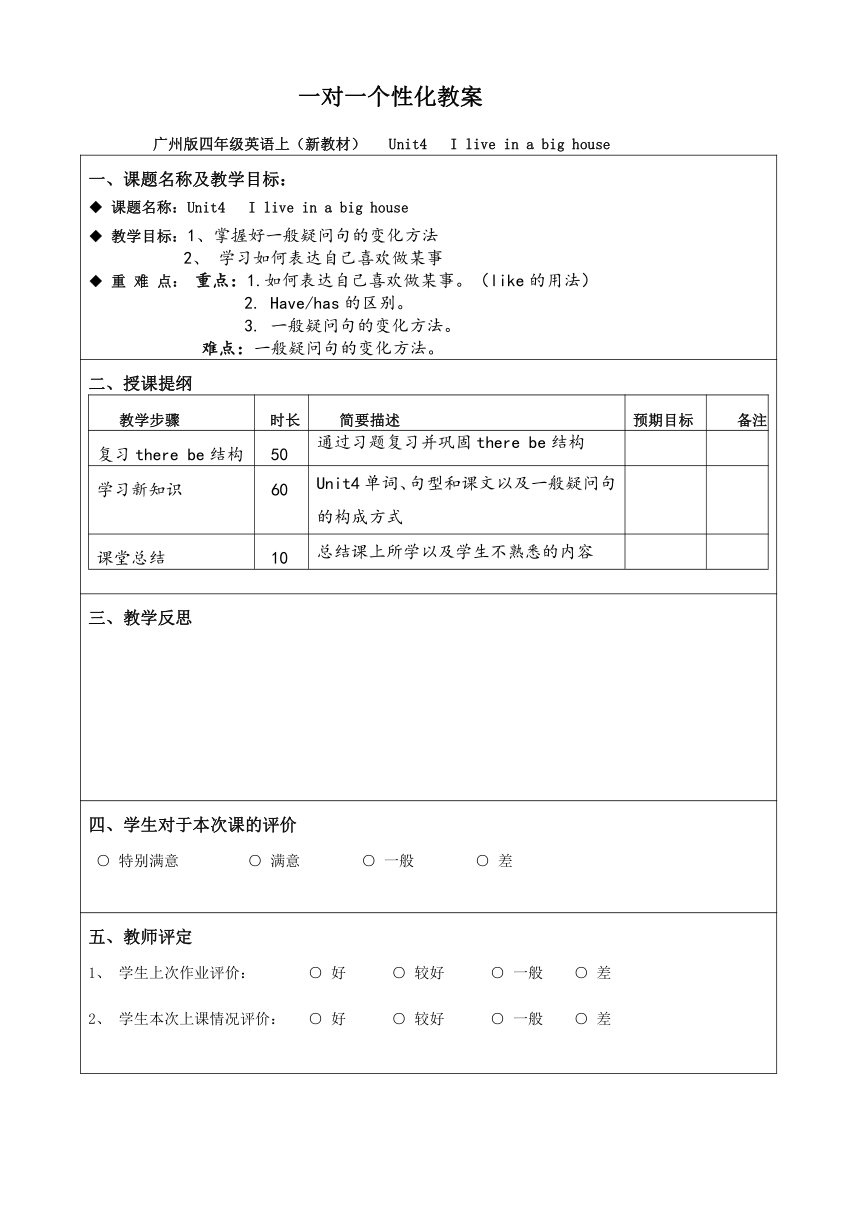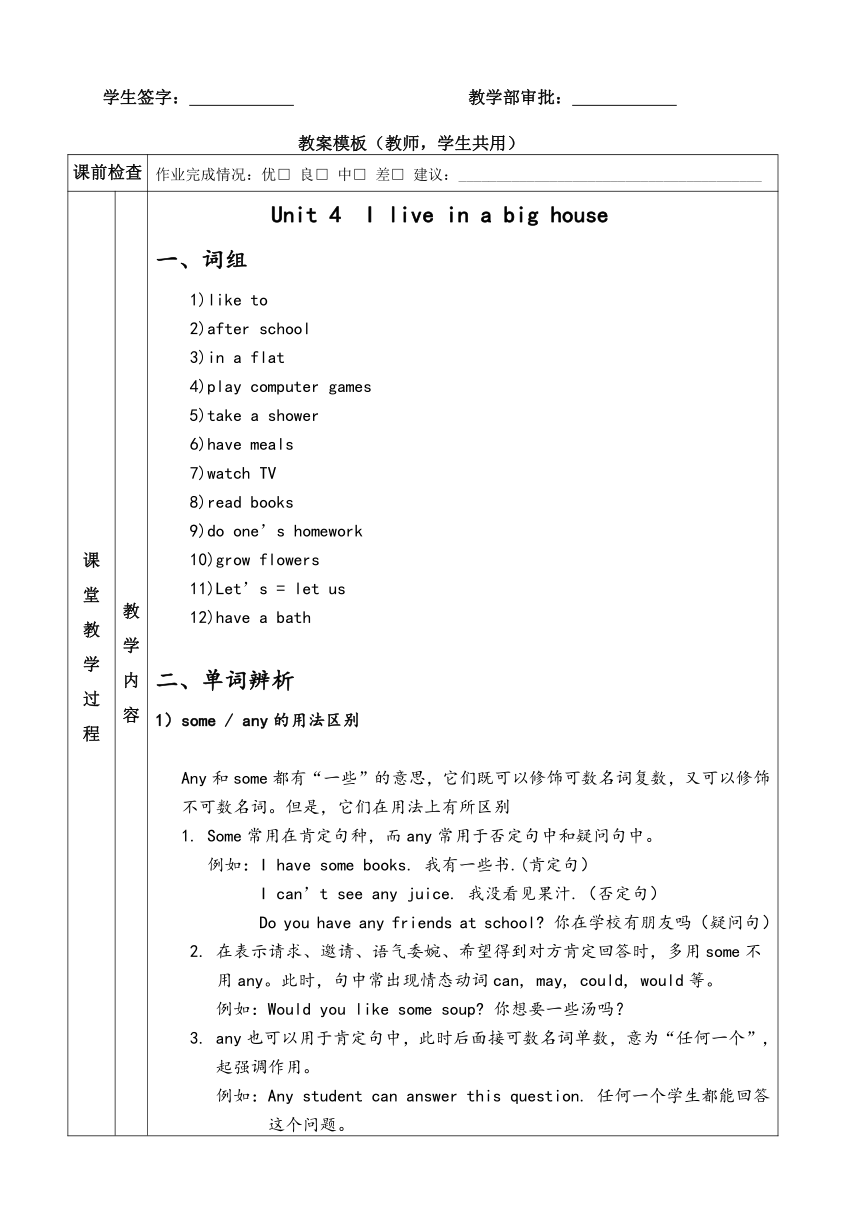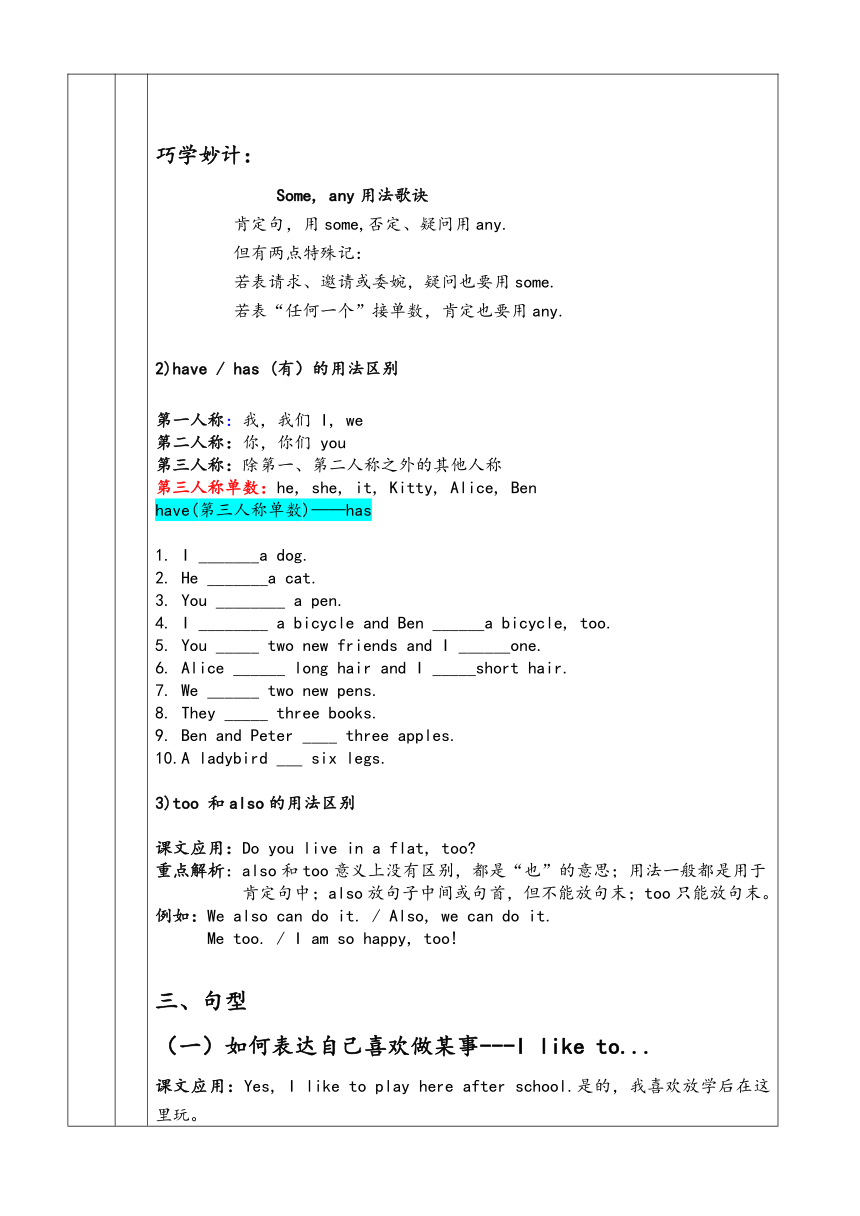Unit4 I live in a big house 教案(深圳专用)
文档属性
| 名称 | Unit4 I live in a big house 教案(深圳专用) |

|
|
| 格式 | zip | ||
| 文件大小 | 20.8KB | ||
| 资源类型 | 教案 | ||
| 版本资源 | 教科版(广州) | ||
| 科目 | 英语 | ||
| 更新时间 | 2016-01-28 18:54:27 | ||
图片预览



文档简介
一对一个性化教案
广州版四年级英语上(新教材) Unit4 I live in a big house
一、课题名称及教学目标:◆ 课题名称:Unit4 I live in a big house◆ 教学目标:1、掌握好一般疑问句的变化方法 2、 学习如何表达自己喜欢做某事◆ 重 难 点: 重点:1.如何表达自己喜欢做某事。(like的用法) 2. Have/has的区别。 3. 一般疑问句的变化方法。 难点:一般疑问句的变化方法。
二、授课提纲教学步骤 时长简要描述预期目标 备注复习there be结构 50通过习题复习并巩固there be结构学习新知识 60Unit4单词、句型和课文以及一般疑问句的构成方式课堂总结 10总结课上所学以及学生不熟悉的内容
教学反思
四、学生对于本次课的评价 ○ 特别满意 ○ 满意 ○ 一般 ○ 差
五、教师评定1、 学生上次作业评价: ○ 好 ○ 较好 ○ 一般 ○ 差2、 学生本次上课情况评价: ○ 好 ○ 较好 ○ 一般 ○ 差
学生签字: 教学部审批:
教案模板(教师,学生共用)
课前检查 作业完成情况:优□ 良□ 中□ 差□ 建议:________________________________________
课堂教学过程 教 学 内 容 Unit 4 I live in a big house词组1)like to2)after school3)in a flat4)play computer games5)take a shower6)have meals7)watch TV8)read books9)do one’s homework10)grow flowers11)Let’s = let us12)have a bath单词辨析some / any的用法区别 Any和some都有“一些”的意思,它们既可以修饰可数名词复数,又可以修饰 不可数名词。但是,它们在用法上有所区别 1. Some常用在肯定句种,而any常用于否定句中和疑问句中。 例如:I have some books. 我有一些书.(肯定句) I can’t see any juice. 我没看见果汁.(否定句) Do you have any friends at school 你在学校有朋友吗(疑问句)在表示请求、邀请、语气委婉、希望得到对方肯定回答时,多用some不 用any。此时,句中常出现情态动词can, may, could, would等。 例如:Would you like some soup 你想要一些汤吗?any也可以用于肯定句中,此时后面接可数名词单数,意为“任何一个”, 起强调作用。 例如:Any student can answer this question. 任何一个学生都能回答 这个问题。巧学妙计: Some, any用法歌诀 肯定句,用some,否定、疑问用any. 但有两点特殊记: 若表请求、邀请或委婉,疑问也要用some. 若表“任何一个”接单数,肯定也要用any.have / has (有)的用法区别第一人称:我,我们 I, we第二人称:你,你们 you第三人称:除第一、第二人称之外的其他人称第三人称单数:he, she, it, Kitty, Alice, Benhave(第三人称单数)——hasI _______a dog.He _______a cat.You ________ a pen.I ________ a bicycle and Ben ______a bicycle, too.You _____ two new friends and I ______one.Alice ______ long hair and I _____short hair.We ______ two new pens.They _____ three books.Ben and Peter ____ three apples.A ladybird ___ six legs.3)too 和also的用法区别课文应用:Do you live in a flat, too 重点解析:also和too意义上没有区别,都是“也”的意思;用法一般都是用于 肯定句中;also放句子中间或句首,但不能放句末;too只能放句末。例如:We also can do it. / Also, we can do it. Me too. / I am so happy, too!三、句型(一)如何表达自己喜欢做某事---I like to...课文应用:Yes, I like to play here after school.是的,我喜欢放学后在这里玩。句型结构:I like to + 动词原形 + 其他。重点解析:此句型用于表达自己喜欢做某事。Like意为“喜欢”,如果后接动作,要用to加上动词原形。例如:I like to swim, but Mary doesn’t like. 我喜欢游泳,但是玛丽不喜欢。四、语法:简介一般疑问句课文应用:Do you live in a flat, too 你住在一个公寓里吗?一般疑问句有以下三种情况:由be动词开头的一般疑问句: 其结构为:Be动词 + 主语 ( http: / / www.21cnjy.com ) + 其它?其中be动词的形式由其主语的人称和数来决定。其答语为:Yes,主语 + be动词./ No,主语 + be动词 + not. 例如:---Is Mary your sister?玛丽是你妹妹吗? ---Yes,she is.是的,她是。 ---Are they your friends 他们是你的朋友吗? ---No,they aren’t. 2)由助动词引导的一般疑问句: 其结构为:Do/Does + ( http: / / www.21cnjy.com ) 主语 + 动词原形 + 其它?当主语是第三人称单数时用does;当主语是其他人称时用do。其答语为:Yes,主语 + do / does./ No,主语 + don’t/doesn’t. 例如:---Do you like apples 你喜欢吃苹果吗? ---Yes,I do. 是的,我喜欢。 ---Does she like painting 她喜欢画画吗? ---No, she doesn’t.不,她不喜欢。 3)由情态动词 ( http: / / www.21cnjy.com )+ 主语 + 动词原形 + 其他?其答语为:Yes,主语 + 情态动词。/ No,主语 + 情态动词 + not。 例如:---May I come in 我可以进来吗? ---Yes, you may. 是的,你可以。 ---Can you speak English 你会说英语吗? ---No, I can’t. 不,我不会。巧学妙计: 一般疑问句的变化规则 一般疑问句并不难,谓语调到主语前。 大写、小写有变化,句末要把问号添。 第一人称变第二,以上规则要记全。课后练习:把下面的字母组成单词,并写出其汉语意思。o, m, c, e ____________________ ( )c, o, l, o, s, h ____________________ ( )l, v, e, o ____________________ ( )e, i, l, v ____________________ ( )5. e, a, u, t, f, u, l, b, i ____________________ ( )给下列短语选择合适的译文。 ( ) 6. have meals ( ) 7. read a book ( ) 8. do one’s homework ( ) 9. take a shower ( ) 10. watch TVA. 淋浴 B. 看电视 C. 用餐D. 读书 E. 做家庭作业单项选择。( ) 11. I like _____ here. A. stay B. stays C. to stay( ) 12. ---Where are my books ---__________________ A. No, they aren’t B. They are on the desk. C.I am on the bed.( ) 13. ---What’s in your room ---_____________________ A. There is a small desk in my room. B. They are on the desk C. It’s a computer( ) 14. I live _____ a big house. A. on B. in C. to( ) 15. There _____ some toys in the room. A. is B. are C. be( ) 16. She _____ two sisters and a brother. A. have B. has C. there is ( ) 17. Do you have ______ new toys A. any B. some C. a ( ) 18. Is there ____ orange window in your house. A. a B. an C. The( ) 19. ______ rabbits _______in the living room. A. How many; is there B. How many; are there C. How much; are there( ) 20. _____ she _____ a dog A. Do; have B. Do; has C. Does; have 根据首字母填空 1. You can cook and eat in the k________. 2. There is a swimming pool in the g_________. 3. You can read a book in the s___________. 4. There are three sofas and two chairs in the l_______________. 5. W___________ to our school.选择合适的选项完成对话。 A:________ do you live B: I live _______ a house. A: Is your house large or small B: It’s _________. A: How many ________ are there B: Five. A: Do you have a garden B: Yes, I do. I like to ______ flowers in it. A. grow B. where C. large D.rooms E. In按要求改写句子。 1. There are some chairs in my bedroom. 否定句:_______________________________________________ 一般疑问句:__________________________________________ 肯定回答:____________________________________________ 否定回答:____________________________________________ 对划线部分提问:________________________________________ 2. Jenny has one dog. 否定句:________________________________________________ 一般疑问句:____________________________________________ 肯定回答:______________________________________________ 否定回答:______________________________________________七、阅读短文,判断正(T)误(F) My name is Kate. There are four people in my family. They are my father, mother, brother and me. My father is a doctor. My mother is a nurse. My brother is a policeman. I am a pupil. I want to be a reporter. I want to get news for people. ( ) 1. There are four people in Kate’s family.( ) 2. Kate’s father is a cook.( ) 3. Kate’s mother is a nurse.( ) 4. Kate’s brother is a writer.( ) 5. Kate wants to be a reporter
课堂检测 听课及知识掌握情况反馈_________________________________________________________。 教学需:加快□; 保持□; 放慢□; 增加内容□; 调整方式□
是否有布置作业:______________ 家长签名确认:______________
广州版四年级英语上(新教材) Unit4 I live in a big house
一、课题名称及教学目标:◆ 课题名称:Unit4 I live in a big house◆ 教学目标:1、掌握好一般疑问句的变化方法 2、 学习如何表达自己喜欢做某事◆ 重 难 点: 重点:1.如何表达自己喜欢做某事。(like的用法) 2. Have/has的区别。 3. 一般疑问句的变化方法。 难点:一般疑问句的变化方法。
二、授课提纲教学步骤 时长简要描述预期目标 备注复习there be结构 50通过习题复习并巩固there be结构学习新知识 60Unit4单词、句型和课文以及一般疑问句的构成方式课堂总结 10总结课上所学以及学生不熟悉的内容
教学反思
四、学生对于本次课的评价 ○ 特别满意 ○ 满意 ○ 一般 ○ 差
五、教师评定1、 学生上次作业评价: ○ 好 ○ 较好 ○ 一般 ○ 差2、 学生本次上课情况评价: ○ 好 ○ 较好 ○ 一般 ○ 差
学生签字: 教学部审批:
教案模板(教师,学生共用)
课前检查 作业完成情况:优□ 良□ 中□ 差□ 建议:________________________________________
课堂教学过程 教 学 内 容 Unit 4 I live in a big house词组1)like to2)after school3)in a flat4)play computer games5)take a shower6)have meals7)watch TV8)read books9)do one’s homework10)grow flowers11)Let’s = let us12)have a bath单词辨析some / any的用法区别 Any和some都有“一些”的意思,它们既可以修饰可数名词复数,又可以修饰 不可数名词。但是,它们在用法上有所区别 1. Some常用在肯定句种,而any常用于否定句中和疑问句中。 例如:I have some books. 我有一些书.(肯定句) I can’t see any juice. 我没看见果汁.(否定句) Do you have any friends at school 你在学校有朋友吗(疑问句)在表示请求、邀请、语气委婉、希望得到对方肯定回答时,多用some不 用any。此时,句中常出现情态动词can, may, could, would等。 例如:Would you like some soup 你想要一些汤吗?any也可以用于肯定句中,此时后面接可数名词单数,意为“任何一个”, 起强调作用。 例如:Any student can answer this question. 任何一个学生都能回答 这个问题。巧学妙计: Some, any用法歌诀 肯定句,用some,否定、疑问用any. 但有两点特殊记: 若表请求、邀请或委婉,疑问也要用some. 若表“任何一个”接单数,肯定也要用any.have / has (有)的用法区别第一人称:我,我们 I, we第二人称:你,你们 you第三人称:除第一、第二人称之外的其他人称第三人称单数:he, she, it, Kitty, Alice, Benhave(第三人称单数)——hasI _______a dog.He _______a cat.You ________ a pen.I ________ a bicycle and Ben ______a bicycle, too.You _____ two new friends and I ______one.Alice ______ long hair and I _____short hair.We ______ two new pens.They _____ three books.Ben and Peter ____ three apples.A ladybird ___ six legs.3)too 和also的用法区别课文应用:Do you live in a flat, too 重点解析:also和too意义上没有区别,都是“也”的意思;用法一般都是用于 肯定句中;also放句子中间或句首,但不能放句末;too只能放句末。例如:We also can do it. / Also, we can do it. Me too. / I am so happy, too!三、句型(一)如何表达自己喜欢做某事---I like to...课文应用:Yes, I like to play here after school.是的,我喜欢放学后在这里玩。句型结构:I like to + 动词原形 + 其他。重点解析:此句型用于表达自己喜欢做某事。Like意为“喜欢”,如果后接动作,要用to加上动词原形。例如:I like to swim, but Mary doesn’t like. 我喜欢游泳,但是玛丽不喜欢。四、语法:简介一般疑问句课文应用:Do you live in a flat, too 你住在一个公寓里吗?一般疑问句有以下三种情况:由be动词开头的一般疑问句: 其结构为:Be动词 + 主语 ( http: / / www.21cnjy.com ) + 其它?其中be动词的形式由其主语的人称和数来决定。其答语为:Yes,主语 + be动词./ No,主语 + be动词 + not. 例如:---Is Mary your sister?玛丽是你妹妹吗? ---Yes,she is.是的,她是。 ---Are they your friends 他们是你的朋友吗? ---No,they aren’t. 2)由助动词引导的一般疑问句: 其结构为:Do/Does + ( http: / / www.21cnjy.com ) 主语 + 动词原形 + 其它?当主语是第三人称单数时用does;当主语是其他人称时用do。其答语为:Yes,主语 + do / does./ No,主语 + don’t/doesn’t. 例如:---Do you like apples 你喜欢吃苹果吗? ---Yes,I do. 是的,我喜欢。 ---Does she like painting 她喜欢画画吗? ---No, she doesn’t.不,她不喜欢。 3)由情态动词 ( http: / / www.21cnjy.com )+ 主语 + 动词原形 + 其他?其答语为:Yes,主语 + 情态动词。/ No,主语 + 情态动词 + not。 例如:---May I come in 我可以进来吗? ---Yes, you may. 是的,你可以。 ---Can you speak English 你会说英语吗? ---No, I can’t. 不,我不会。巧学妙计: 一般疑问句的变化规则 一般疑问句并不难,谓语调到主语前。 大写、小写有变化,句末要把问号添。 第一人称变第二,以上规则要记全。课后练习:把下面的字母组成单词,并写出其汉语意思。o, m, c, e ____________________ ( )c, o, l, o, s, h ____________________ ( )l, v, e, o ____________________ ( )e, i, l, v ____________________ ( )5. e, a, u, t, f, u, l, b, i ____________________ ( )给下列短语选择合适的译文。 ( ) 6. have meals ( ) 7. read a book ( ) 8. do one’s homework ( ) 9. take a shower ( ) 10. watch TVA. 淋浴 B. 看电视 C. 用餐D. 读书 E. 做家庭作业单项选择。( ) 11. I like _____ here. A. stay B. stays C. to stay( ) 12. ---Where are my books ---__________________ A. No, they aren’t B. They are on the desk. C.I am on the bed.( ) 13. ---What’s in your room ---_____________________ A. There is a small desk in my room. B. They are on the desk C. It’s a computer( ) 14. I live _____ a big house. A. on B. in C. to( ) 15. There _____ some toys in the room. A. is B. are C. be( ) 16. She _____ two sisters and a brother. A. have B. has C. there is ( ) 17. Do you have ______ new toys A. any B. some C. a ( ) 18. Is there ____ orange window in your house. A. a B. an C. The( ) 19. ______ rabbits _______in the living room. A. How many; is there B. How many; are there C. How much; are there( ) 20. _____ she _____ a dog A. Do; have B. Do; has C. Does; have 根据首字母填空 1. You can cook and eat in the k________. 2. There is a swimming pool in the g_________. 3. You can read a book in the s___________. 4. There are three sofas and two chairs in the l_______________. 5. W___________ to our school.选择合适的选项完成对话。 A:________ do you live B: I live _______ a house. A: Is your house large or small B: It’s _________. A: How many ________ are there B: Five. A: Do you have a garden B: Yes, I do. I like to ______ flowers in it. A. grow B. where C. large D.rooms E. In按要求改写句子。 1. There are some chairs in my bedroom. 否定句:_______________________________________________ 一般疑问句:__________________________________________ 肯定回答:____________________________________________ 否定回答:____________________________________________ 对划线部分提问:________________________________________ 2. Jenny has one dog. 否定句:________________________________________________ 一般疑问句:____________________________________________ 肯定回答:______________________________________________ 否定回答:______________________________________________七、阅读短文,判断正(T)误(F) My name is Kate. There are four people in my family. They are my father, mother, brother and me. My father is a doctor. My mother is a nurse. My brother is a policeman. I am a pupil. I want to be a reporter. I want to get news for people. ( ) 1. There are four people in Kate’s family.( ) 2. Kate’s father is a cook.( ) 3. Kate’s mother is a nurse.( ) 4. Kate’s brother is a writer.( ) 5. Kate wants to be a reporter
课堂检测 听课及知识掌握情况反馈_________________________________________________________。 教学需:加快□; 保持□; 放慢□; 增加内容□; 调整方式□
是否有布置作业:______________ 家长签名确认:______________
同课章节目录
- Module 1 My bedroom
- Unit 1 What's in your room?
- Unit 2 They're near the window
- Module 2 My house
- Unit 3 Welcome to my house
- Unit 4 I live in a big house
- Module 3 My school
- Unit 5 Let me show you our new school
- Unit 6 How many classrooms are there in your schoo
- Module 4 My class
- Unit 7 How many stars does each group have?
- Unit 8 I like English best
- Module 5 Clothes
- Unit 9 Look at this T-shirt
- Unit 10 Can I help you?
- Module 6 Occupations
- Unit 11 I want to be a painter
- Unit 12 What's your father's job?
- Module 7 Let's look back
